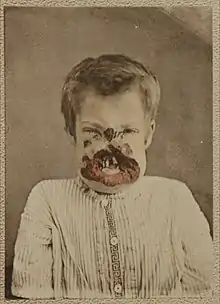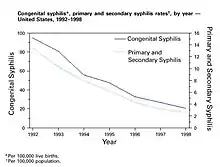Congenital syphilis
Congenital syphilis is syphilis that occurs when a mother with untreated syphilis passes the infection to her baby during pregnancy or at birth.[4] It may present in the fetus, infant, or later.[1][5] Clinical features vary and differ between early onset, that is presentation before age 2-years of age, and late onset, presentation after age 2-years.[4] Infection in the unborn baby may present as poor growth, non-immune hydrops leading to premature birth or loss of the baby, or no signs.[2][4] Affected newborns mostly initially have no clinical signs.[4] They may be small and irritable.[4] Characteristic features include a rash, fever, large liver and spleen, a runny and congested nose, and inflammation around bone or cartilage.[2][4] There may be jaundice, large glands, pneumonia, meningitis, warty bumps on genitals, deafness or blindness.[4][6] Untreated babies that survive the early phase may develop skeletal deformities including deformity of the nose, lower legs, forehead, collar bone, jaw, and cheek bone.[4] There may be a perforated or high arched palate, and recurrent joint disease.[2][4] Other late signs include linear perioral tears, intellectual disability, hydrocephalus, and juvenile general paresis.[4] Seizures and cranial nerve palsies may first occur in both early and late phases.[4] Eighth nerve palsy, interstitial keratitis and small notched teeth may appear individually or together; known as Hutchinson's triad.[4]
| Congenital syphilis | |
|---|---|
 | |
| Notched incisors known as Hutchinson's teeth which are characteristic of congenital syphilis | |
| Specialty | Infectious diseases |
| Symptoms | Rash, fever, large liver and spleen, skeletal abnormalities[1] |
| Usual onset | Unborn baby, newborn baby or later[1] |
| Duration | Lifelong |
| Types | Early & late[2] |
| Causes | Treponema pallidum[2] |
| Diagnostic method | Signs, symptoms, blood tests, CSF tests |
| Prevention | Adequate screening and treatment in pregnant mother[2] |
| Treatment | Antibiotic[3] |
| Medication | Penicillin by injection; Procaine benzylpenicillin, benzylpenicillin, benzathine penicillin G[3] |

It is caused by the bacterium Treponema pallidum subspecies pallidum when it infects the baby after crossing the placenta or from contact with a syphilitic sore at birth.[4][5] It is not transmitted during breastfeeding unless there is an open sore on the mother's breast.[4] The unborn baby can become infected at any time during the pregnancy.[4] Most cases occur due to inadequate antenatal screening and treatment during pregnancy.[7] The baby is highly infectious if the rash and snuffles are present.[4] The disease may be suspected from tests on the mother; blood tests and ultrasound.[8] Tests on the baby may include blood tests, CSF analysis and medical imaging.[9] Findings may reveal anemia and low platelets.[4] Other findings may include low sugars, proteinuria and hypopituitarism.[4] The placenta may appear large and pale.[4] Other investigations include testing for HIV.[9]
Prevention is by safe sex to prevent syphilis in the mother, and early screening and treatment of syphilis in pregnancy.[6] One intramuscular injection of benzathine penicillin G administered to a pregnant woman early in the illness can prevent congenital syphilis in her baby.[10] Treatment of suspected congenital syphilis is with penicillin by injection; benzylpenicillin into vein, or procaine benzylpenicillin into muscle.[3][9] During times of penicillin unavailability, ceftriaxone may be an alternative.[9] Where there is penicillin allergy, antimicrobial desensitisation is an option.[9][11]
Syphilis affects around one million pregnancies a year.[12] In 2016, there were around 473 cases of congenital syphilis per 100,000 live births and 204,000 deaths from the disease worldwide.[13] Of the 660,000 congenital syphilis cases reported in 2016, 143,000 resulted in deaths of unborn babies, 61,000 deaths of newborn babies, 41,000 low birth weights or preterm births, and 109,000 young children diagnosed with congenital syphilis.[14] Around 75% were from the WHO's African and Eastern Mediterranean regions.[2] Serological tests for syphilis were introduced in 1906, and it was later shown that transmission occurred from the mother.[15]
Signs and symptoms
Untreated early syphilis infections results in a high risk of poor pregnancy outcomes, including saddle nose, lower extremity abnormalities, miscarriages, premature births, stillbirths, or death in newborns. Some infants with congenital syphilis have symptoms at birth, but many develop symptoms later. Symptoms may include rash, fever, large liver and spleen, and skeletal abnormalities.[16] Newborns will typically not develop a primary syphilitic chancre but may present with signs of secondary syphilis (i.e. generalized body rash). Often these babies will develop syphilitic rhinitis ("snuffles"), the mucus from which is laden with the T. pallidum bacterium, and therefore highly infectious. If a baby with congenital syphilis is not treated early, damage to the bones, teeth, eyes, ears, and brain can occur.[16]
Early

_(14597432110).jpg.webp)
This is a subset of cases of congenital syphilis. Newborns may be asymptomatic and are only identified on routine prenatal screening. If not identified and treated, these newborns develop poor feeding and runny nose.[16] By definition, early congenital syphilis occurs in children between 0 and 2 years old.[17]
Late


Late congenital syphilis is a subset of cases of congenital syphilis. By definition, it occurs in children at or greater than 2 years of age who acquired the infection trans-placentally.[17]
Symptoms include:[18]
- Blunted upper incisor teeth known as Hutchinson's teeth
- Deafness from auditory nerve disease
- Frontal bossing (prominence of the brow ridge)
- Hard palate defect
- Inflammation of the cornea known as interstitial keratitis
- Protruding mandible
- Saber shins
- Saddle nose (collapse of the bony part of nose)
- Short maxillae
- Swollen knees
A frequently-found group of symptoms is Hutchinson's triad, which consists of Hutchinson's teeth (notched incisors), keratitis and deafness and occurs in 63% of cases.[18]
Treatment (with penicillin) before the development of late symptoms is essential.[19]
- Abnormal x-rays
- Anemia[20]
- Cerebral palsy
- Du Bois sign, narrowing of the little finger
- Enlarged liver[1]
- Enlarged spleen[1]
- Frontal bossing
- Sensorineural hearing loss
- Higouménakis' sign, enlargement of the sternal end of clavicle in late congenital syphilis
- Hutchinson's triad, a set of symptoms consisting of deafness, Hutchinson's teeth (centrally notched, widely spaced peg-shaped upper central incisors), and interstitial keratitis (IK), an inflammation of the cornea which can lead to corneal scarring and potential blindness
- Hydrocephalus
- Jaundice
- Lymph node enlargement
- Mulberry molars (permanent first molars with multiple poorly developed cusps)[21]
- Musculoskeletal deformities
- Petechiae
- Poorly developed maxillae
- Pseudoparalysis
- Rhagades, linear scars at the angles of the mouth and nose result from bacterial infection of skin lesions
- Snuffles, aka "syphilitic rhinitis", which appears similar to the rhinitis of the common cold, except it is more severe, lasts longer, often involves bloody rhinorrhea, and is often associated with laryngitis[22]
- Sabre shins
- Skin rash[1]
Death from congenital syphilis is usually due to bleeding into the lungs.
Diagnosis
Serological testing is carried out on the mother and the infant. If the neonatal IgG antibody titres are significantly higher than the mother's, then congenital syphilis can be confirmed. Specific IgM in the infant is another method of confirmation. CSF pleocytosis, raised CSF protein level and positive CSF serology suggest neurosyphilis.[23]
Treatment

If a pregnant mother is identified as being infected with syphilis, treatment can effectively prevent congenital syphilis from developing in the fetus, especially if she is treated before the sixteenth week of pregnancy.[2] The fetus is at greatest risk of contracting syphilis when the mother is in the early stages of infection, but the disease can be passed at any point during pregnancy, even during delivery (if the child had not already contracted it). A woman in the secondary stage of syphilis decreases her fetus's risk of developing congenital syphilis by 98% if she receives treatment before the last month of pregnancy.[24] An affected child can be treated using antibiotics much like an adult; however, any developmental symptoms are likely to be permanent.[25]
Kassowitz's law is an empirical observation used in context of congenital syphilis stating that the greater the duration between the infection of the mother and conception, the better the outcome for the infant. Features of a better outcome include less chance of stillbirth and of developing congenital syphilis.[26]
The Centers for Disease Control and Prevention recommends treating symptomatic or babies born to an infected mother with unknown treatment status with procaine penicillin G, 50,000 U/kg dose IM a day in a single dose for 10 days.[27] Treatment for these babies can vary on a case-by-case basis. Treatment cannot reverse any deformities, brain, or permanent tissue damage that has already occurred.[25]
A Cochrane review found that antibiotics may be effective for serological cure but in general the evidence around the effectiveness of antibiotics for congenital syphilis is uncertain due to the poor methodological quality of the small number of trials that have been conducted.[28]
Epidemiology

Syphilis affects around one million pregnancies a year.[12] In 2016, there were around 473 cases of congenital syphilis per 100,000 live births and 204,000 deaths from the disease worldwide.[13] Of the 660,000 congenital syphilis cases reported in 2016, 143,000 resulted in deaths of unborn babies, 61,000 deaths of newborn babies, 41,000 low birth weights or preterm births, and 109,000 young children diagnosed with congenital syphilis.[14] Around 75% were from the WHO's African and Eastern Mediterranean regions.[2]
Cases in the United States have been increasingly rising in the 2010s. The Centers for Disease Control and Prevention (CDC) reported 918 cases for 2017, what is more than twice the figures of four years earlier.[29] Reports in 2023 show a rise of more than 900 percent in Mississippi over five years.[30]
History
Nineteenth century physicians held the belief that congenital syphilis was contracted from contaminated semen at time of conception.[15] Serological tests for syphilis were introduced in 1906, and it was later shown that transmission occurred from the mother.[15]
References
- Ghanem, Khalil G.; Hook, Edward W. (2020). "303. Syphilis". In Goldman, Lee; Schafer, Andrew I. (eds.). Goldman-Cecil Medicine. Vol. 2 (26th ed.). Philadelphia: Elsevier. p. 1986. ISBN 978-0-323-55087-1.
- Adamson, Paul C.; Klausner, Jeffrey D. (2022). "60. Syphilis (Treponema palladium)". In Jong, Elaine C.; Stevens, Dennis L. (eds.). Netter's Infectious Diseases (2nd ed.). Philadelphia: Elsevier. pp. 339–347. ISBN 978-0-323-71159-3.
- Ferri, Fred F. (2022). "Syphilis". Ferri's Clinical Advisor 2022. Philadelphia: Elsevier. pp. 1452–1454. ISBN 978-0-323-75571-9.
- Medoro, Alexandra K.; Sánchez, Pablo J. (June 2021). "Syphilis in Neonates and Infants". Clinics in Perinatology. 48 (2): 293–309. doi:10.1016/j.clp.2021.03.005. ISSN 1557-9840. PMID 34030815. S2CID 235200042. Archived from the original on 2022-07-20. Retrieved 2023-05-10.
- James, William D.; Elston, Dirk; Treat, James R.; Rosenbach, Misha A.; Neuhaus, Isaac (2020). "18. Syphilis, Yaws, Bejel, and Pinta". Andrews' Diseases of the Skin: Clinical Dermatology (13th ed.). Edinburgh: Elsevier. pp. 347–361. ISBN 978-0-323-54753-6.
- "STD Facts - Congenital Syphilis". www.cdc.gov. 10 April 2023. Archived from the original on 21 April 2023. Retrieved 9 May 2023.
- Gilmour, Leeyan S.; Walls, Tony (15 March 2023). "Congenital Syphilis: a Review of Global Epidemiology". Clinical Microbiology Reviews. 36 (2): e0012622. doi:10.1128/cmr.00126-22. ISSN 1098-6618. PMC 10283482. PMID 36920205. S2CID 257535283.
- "Congenital Syphilis". Centers for Disease Control and Prevention. 1 April 2021. Archived from the original on 13 April 2023. Retrieved 12 May 2023.
- "Congenital Syphilis - STI Treatment Guidelines". www.cdc.gov. 19 October 2022. Archived from the original on 1 April 2023. Retrieved 9 May 2023.
- WHO guideline on syphilis screening and treatment for pregnant women. Geneva: World health Organization. 2017. ISBN 978-92-4-155009-3.
- Chastain, DB; Hutzley, VJ; Parekh, J; Alegro, JVG (9 August 2019). "Antimicrobial Desensitization: A Review of Published Protocols". Pharmacy. 7 (3): 112. doi:10.3390/pharmacy7030112. PMC 6789802. PMID 31405062.
- Hussain, Syed A.; Vaidya, Ruben (2023). "Congenital Syphilis". StatPearls. StatPearls Publishing. PMID 30725772. Archived from the original on 2022-12-10. Retrieved 2023-05-12.
- Global progress report on HIV, viral hepatitis and sexually transmitted infections, 2021 (PDF). Geneva: World Health Organization. 2021. ISBN 978-92-4-003098-5. Archived (PDF) from the original on 2023-03-26. Retrieved 2023-05-08.
- "Congenital syphilis - Mother-to-child transmission of syphilis". www.who.int. Archived from the original on 21 April 2023. Retrieved 9 May 2023.
- Oriel, J. David (2012). "5. "The sins of the fathers": Congenital syphilis". The Scars of Venus: A History of Venereology. London: Springer-Verlag. pp. 69–70. ISBN 978-1-4471-2068-1.
- "Congenital syphilis: MedlinePlus Medical Encyclopedia". medlineplus.gov. Retrieved 2021-11-17.
- Tsimis, Michael E.; Sheffield, Jeanne S. (2017-03-15). "Update on syphilis and pregnancy". Birth Defects Research. 109 (5): 347–352. doi:10.1002/bdra.23562. ISSN 2472-1727. PMID 28398683. S2CID 1026966.
- "Congenital Syphilis". University of Pittsburgh.
- "Sexually Transmitted Diseases Treatment Guidelines - 2002". Cdc.gov. Retrieved 2013-01-21.
- "Anemia: Overview". The Lecturio Medical Concept Library. Retrieved 28 June 2021.
- Hillson, S; Grigson, C; Bond, S (1998). "Dental defects of congenital syphilis". Am J Phys Anthropol. 107 (1): 25–40. doi:10.1002/(SICI)1096-8644(199809)107:1<25::AID-AJPA3>3.0.CO;2-C. ISSN 0002-9483. PMID 9740299.
- Darville, T. (1 May 1999). "Syphilis". Pediatrics in Review. 20 (5): 160–165. doi:10.1542/pir.20-5-160. PMID 10233174.
- South, Mike (2012). Practical Paediatrics (7th ed.). Churchill Livingstone Elsevier. pp. 368, 830. ISBN 9780702042928.
- Congenital syphilis.
- Arnold, S; Ford-Jones, L (November–December 2000). "Congenital syphilis: A guide to diagnosis and management". Paediatrics & Child Health. 5 (8): 463–469. doi:10.1093/pch/5.8.463. PMC 2819963. PMID 20177559.
- Singh, Ameeta E.; Romanowski, Barbara (1 April 1999). "Syphilis: Review with Emphasis on Clinical, Epidemiologic, and Some Biologic Features". Clinical Microbiology Reviews. 12 (2): 187–209. doi:10.1128/CMR.12.2.187. PMC 88914. PMID 10194456.
- "Sexually Transmitted Diseases: Treatment Guidelines, 2010 By: the CDC". Retrieved July 21, 2019.
- Walker, GJ; Walker, D; Molano Franco, D; Grillo-Ardila, CF (15 February 2019). "Antibiotic treatment for newborns with congenital syphilis". The Cochrane Database of Systematic Reviews. 2019 (2): CD012071. doi:10.1002/14651858.CD012071.pub2. PMC 6378924. PMID 30776081.
- "A Devastating Surge in Congenital Syphilis: How Can We Stop It?". Medscape. Retrieved 2023-02-15.
- Yang, Maya (2023-02-12). "Mississippi sees 900% rise in number of infants born with congenital syphilis". The Guardian. ISSN 0261-3077. Retrieved 2023-02-15.
External links
![]() Media related to Congenital syphilis at Wikimedia Commons
Media related to Congenital syphilis at Wikimedia Commons